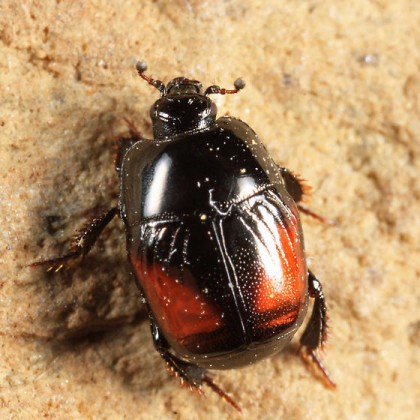
The beetle pictured above is the Histerid beetle, Baeckmanniolus dimidiatipennis. We have recently learned that it is a prominent constituent the under-sand invertebrate community associated with horseshoe crab eggs.
I wrote last year about the various critters living among developing horseshoe crab eggs on Delaware Bay beaches, at a loss for exactly what they were and what they were doing in and around the eggs.
We’ve continued to see these worms and larvae this year, and luckily we were connected with an entomologist, Ray Pupedis, who is engaged in documenting the phenomenon throughout the range of American horseshoe crabs.
Thanks to this expert assistance, we now know that one of the critters we are seeing among the eggs is the larva of Baeckmanniolus dimidiatipennis.
Note that the beetle larva looks green, just like the horseshoe crab egg and embryo next to it.
Sometimes they are pure white, which makes me suspect that they are eating the horseshoe crab eggs. At this point we can’t be sure.
The beetle is likely not a specialist on horseshoe crab eggs. It is a generalist that feeds and lays eggs among decaying vegetation and the rotting carcasses of marine life. But it seems that among its repertoire is the ability to exploit some resource associated with horseshoe crab eggs.
Now that our team is aware of the beetle, it is suddenly everywhere. During the course of our field work observing horseshoe crab egg clusters, we are now noticing adult beetles among the egg clusters — there to lay eggs.
The beetles take two forms: all black and a red-and-black form at the beginning of the post.
Much work remains to merely figure out the story with the beetle, let alone the various other creatures among the eggs.
First, the beetle needs to be positively identified (many species look alike) and the link between the adult beetles and the larvae must be made to confirm that they are the same species.
In order to make this link, the missing link must be found: the pupae.
We had the good fortune to find numerous pupae along with newly emerged adults still within their pupal case during our day in the field with the visiting entomologist. As a result Ray will soon get a positive identification of both adults and larvae.
Alas, the beetles are only the beginning. Among the other larvae tumbling out of horseshoe crab egg clusters as we dig, are a variety of fly larvae.
And then there is the most ubiquitous critter of them all – the nematodes, beyond even our entomologist friend’s comprehension
This is new scholarly terrain. Until Ray’s current effort, no one has yet attempted to document the invertebrate associates of horseshoe crab eggs. Ultimately these investigations will lead to a richer understanding of the ecological role that horseshoe crabs and their eggs play in the nearshore ecosystem.
So far we’ve got the connection between horseshoe crab eggs and birds pretty well figured out, but we still have a long way to go in our understanding of the many other connections these eggs have with creatures under the sea and the small, obscure creatures under the sand.